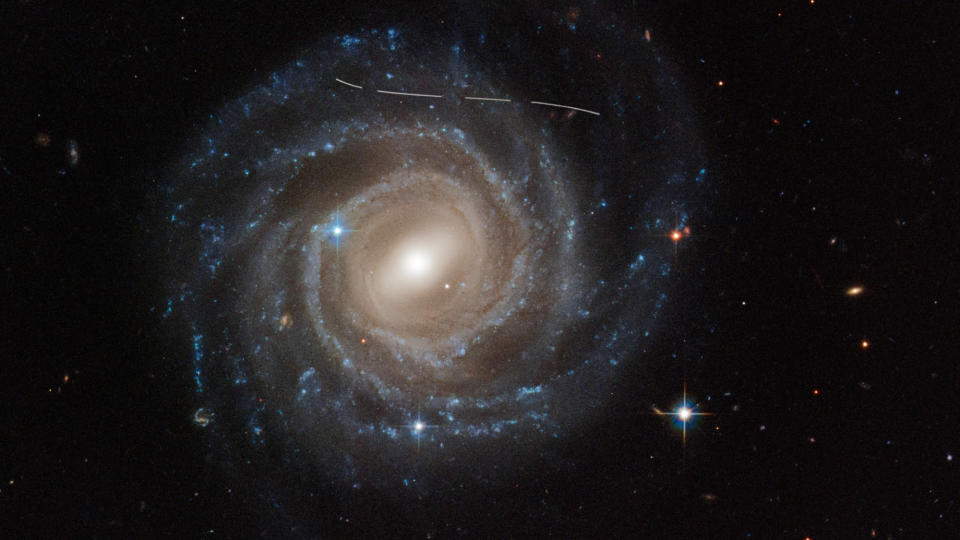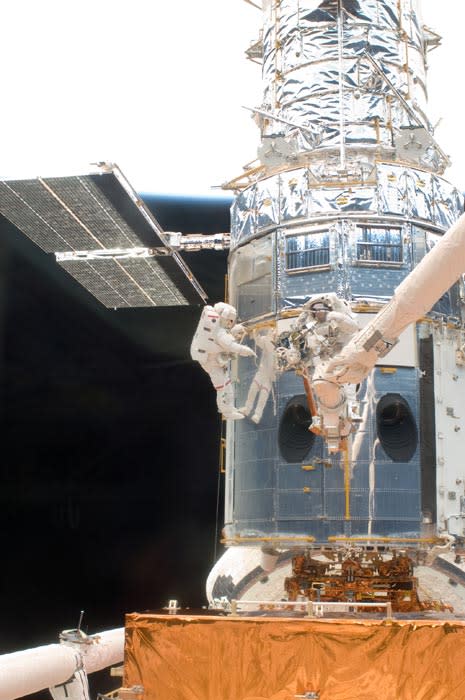We’ll get an update on NASA’s Hubble Space Telescope tomorrow (June 4), and it could be a pretty big deal.
On June 3, the agency announced that the Hubble Space Telescope team will hold a press conference tomorrow at 4:00 PM EDT (2000 GMT) on the status of the observatory. Specifically, officials said the purpose of this meeting will be to “provide an update on operations” for the telescope. Sounds routine, right? Well, not necessarily. The Hubble Telescope team doesn’t hold press conferences like this often – especially when there are only two presenters, both of whom have rather lofty titles.
Mark Clampin, director of the Astrophysics Division and Science Mission Directorate at NASA Headquarters, will speak, as will Patrick Crouse, Hubble’s project manager at NASA’s Goddard Space Flight Center in Maryland.
Related: A billionaire hopes to upgrade the Hubble telescope during a private SpaceX mission, but could that really happen?
The news comes three days after NASA announced that Hubble went into automatic safe mode due to faulty readings from one of the last three operating gyroscopes, devices that help scientists ensure the telescope is pointing in the right direction. Since its launch in 1990, Hubble has gone through a number of gyroscopes, including some replacements. Now three remain.
Before you worry too much: Yes, that may seem like a terrible combination of isolated facts. However, there is some context in which we can place them – a context that offers hope. Hubble isn’t finished with its tasks yet.
First, in its release about the upcoming conference, NASA said something that agency officials have repeated again and again: “NASA expects Hubble to continue making discoveries this decade, working with other observatories such as the James Webb Space Telescope.” the agency. to the next.”
This is a sentiment shared during previous gyroscope problems that Hubble also encountered, including earlier this year and late last year; this latest incident actually involved a short series of complications that were all resolved. Yet neither required a conference to notify the public that Hubble was at it again. Online announcements were sufficient.
Which brings us to the next point: Hubble doesn’t really need all three gyroscopes to work.

As NASA has stated, Hubble technically only needs one gyroscope to function properly – although according to the European Space Agency (which is working with NASA on the mission), the single-gyroscope mode may limit scientific observations to some extent.
But even if the telescope’s now malfunctioning gyroscope turns out to be out of track, there are two that will allow the cosmic explorer to continue exploring the universe. For example, in 2004 the observatory was placed in dual-gyroscope mode after a planned Hubble servicing mission was canceled in the wake of the Columbia Space Shuttle tragedy. Ultimately, Hubble Servicing Mission 4 replaced all six gyroscopes for the final time in 2009, and a fifth servicing mission eventually followed. But then again, Hubble now only has three of those gyroscopes left, one of which is the source of the final track. The other three all experienced what is known as a ‘flex lead fail’, which has to do with wiring.
According to a NASA glitch, in the event that there are only two total gyroscopes working, the team will keep one and put the other in reserve. That way, if one of the two remaining gyroscopes fails, the other one that was resting will be nice and fresh and ready for Hubble’s final stretch.
Last piece? Hopefully not, but it is unfortunately true that scientists believe the telescope will be decommissioned in the mid-to-late 2030s as our planet’s atmospheric drag force slowly brings the spacecraft down from its orbit about 320 miles (515 kilometers) above Earth.
Such a decommissioning would involve either a controlled reentry of the telescope into Earth’s atmosphere, or a small boost of the telescope to higher Earth orbit, where it could rest safely for a few decades. If Hubble reenters the atmosphere, it would burn up much of the way other spacecraft do in the process – but it’s too big to whole burn out. I imagine that anything that could be saved would be preserved with the honor it deserves.
If you’re stuck on that brief mention of servicing the spacecraft in orbit, as astronauts famously did in the early years, it’s unclear if that’s still a possibility.
In the late 1990s and early 2000s, brave NASA astronauts managed to drive to orbit and tinker with the observatory to install upgrades and make renovations. The aforementioned maintenance missions 4 and 5 were part of this effort. Consider a microgravity body for a space telescope that also requires space walks.
The most famous Hubble servicing mission is probably the first, which took place shortly after the telescope was launched into space, because its groundbreaking science data appeared corrupted when it returned to Earth. Hubble’s images were, to put it simply, blurry, and scientists realized they had accidentally given the spacecraft a defective mirror. No problem, the agency said, and sent astronauts to make the necessary adjustments. In space!


Related stories:
— 30 years ago astronauts saved the Hubble Space Telescope
— The dusty galaxy looks like a cosmic net in a beautiful new Hubble telescope photo
— The bejeweled galaxy of ‘Bernice’s Hair’ shines in a new Hubble Telescope photo
Recently, billionaire Jared Isaacman, who is prominent in the commercial space sector thanks to the successful Inspiration4 all-civil space launch he funded and his upcoming Polaris Dawn project, attempted to revive the Hubble service concept. However, this concept has not yet come to fruition and it is uncertain whether it ever will.
That said – and I am aware of the hypocrisy behind what I am about to say – speculation is the enemy of optimism.
Theoretically anything is possible, we’ll know more about Hubble’s fate soon, and it’s probably best to postpone our worries until there’s something to worry about. Furthermore, Hubble has generally continued to transmit space images as if nothing has changed. A new stellar portrait emerged today, and Hubble had a hand in its construction. It’s a very cool image of a young star with a comet-like tail, as other stars (hidden in the image) pull on the material.
Editor’s update 3/6: On May 31, NASA announced that Hubble had entered safe mode.